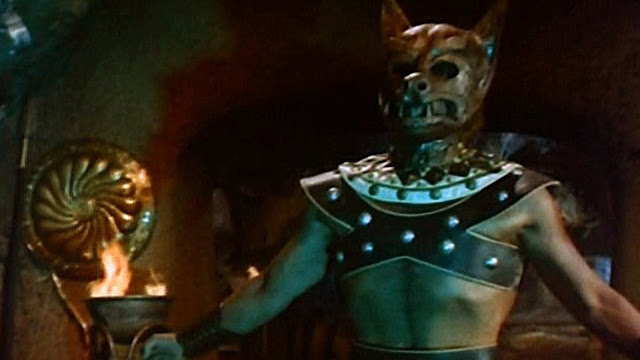PHENOMENALITY: *marvelous*
MYTHICITY: *fair*
FRYEAN MYTHOS: *adventure*
CAMPBELLIAN FUNCTION: *metaphysical, sociological*
Though some elements of this sword-and-sandal seem borrowed from Greek mythology, particularly the story of the Minotaur, both the "Hercules" and the "Moloch" are mortals who pretend to be divine figures for one reason or another. And despite all the mythic content, one of the film's alternate titles was CONQUEST OF MYCENAE, as if someone, perhaps director Giorgio Ferrone, thought of marketing the film as a quasi-naturalistic story of archaic warfare.
Mycenae is ostensibly the walled city from which evil Queen Demetra (Rosalba Neri) seeks to conquer all of her neighbors, particularly the rival city of Tiryns. Demetra took control of Mycenae by becoming the second wife of the now-deceased king, and after he was gone she instituted a cult of human sacrifice. Many of the local women-- all beautiful stunners, of course-- are given into the hands of Demetra's son from a previous marriage, who has given himself the name of the Semitic deity Moloch. Instead of being a demi-human monster like The Minotaur, Moloch is a disfigured man who hides his ruined features behind a metal wolf's mask, and he both mutilates and murders his victims because he claims to hate all beauty. In addition to keeping Mycenae in thrall to the cult of sacrifice, Demetra also makes sure that the former king's daughter Medea (Alessandra Panaro) doesn't get any ideas about taking power, even though Medea represents the power of a rival deity, "the Earth Goddess."
While Demetra and her generals plan to invade Tiryns, Glaucus (Gordon Scott), prince of that city, goes undercover, pretending to be a slave so as to gain entrance to Mycenae and to spy on his enemies. He swiftly becomes a gladiator, this being the time-approved method of attracting the attention of lusty evil queens. As one might expect, both the bad queen and the good stepdaughter fall for Glaucus, who further beefs up his reputation by claiming to be the demigod Hercules.
Battles, intrigues and betrayals follow, including major action between the forces of Mycenae and Tiryns. Demetra seems to be set up for a fall when the Earth-goddess trumps her sacrificial cult, striking down Demetra's high priest with a lightning bolt, and so the populace of Mycenae rebels. This would seem to set up a nasty end for Demetra. However, in the version I saw, Neri's character simply disappears. Possibly the production was running low on money? In the big climactic scene where Glaucus descends into an underground cavern to rescue Medea from Moloch, director Ferrone suddenly interpolates a sequence that looks like it was taken (or re-created) from Ferrone's earlier epic, the 1961 BACCHANTES. For about four minutes a bunch of soldiers, whose identity is unclear, find themselves confounded by a group of drum-beating witch-women-- who then disappear when that sequence is over. This leaves the field clear for a nice long brawl between Glaucus and Moloch; one guess who wins.
One last detail is that although some peplum-films make interesting usages of Classic Greek mythological names, the scripters here, including Ferroni, just toss in names with no resonance to their Greek originals. In addition to Glaucus, Medea and Demetra (Demeter), we also get a Pentheus, a Deianeira, and a Pasifae-- the latter name being the only one appropriate to a story about a monster that murders his sacrificial victims.

No comments:
Post a Comment